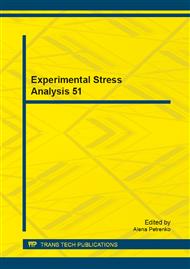p.327
p.333
p.341
p.347
p.353
p.359
p.371
p.379
p.387
Influence of Freeze-Thaw Cycles on Mechanical Properties of Gypsum Determined Using the Impulse Excitation Method
Abstract:
Non-destructive methods for testing mechanical properties of materials spreads to many fields of investigation at present. A typical example of the use of non-destructive testing can be determination of the effect of freeze-thaw cycles on the mechanical properties of porous building materials. The great advantage of non-destructive testing, compared to destructive, is that still the same sample is tested and it excludes various negative effects such as technological indiscipline in the production of samples, different environment storage of samples prior to testing, recognition of cracks in the sample prior to testing, etc. The paper presents the development of modulus of elasticity on samples of hardened plaster according to the number of freeze-thaw cycles. Elastic moduli were determined using an impulse excitation method. For cyclic loading, the samples were saturated with water at 20 °C and tested in 8-hour cycles. Samples were removed from the water bath and placed in a freezer with a temperature lower than - 20 °C and after 8 hours they were placed again in the water bath for a period of eight hours. The temperature in the freezer was measured using platinum thermometers during the freeze-thaw cycles. The difference from 'dry' frost resistance was that the samples of hardened plaster were exposed to "wet" frost resistance, i.e. to the extreme load of the samples with the external climatic conditions.
Info:
Periodical:
Pages:
353-358
Citation:
Online since:
December 2013
Authors:
Price:
Сopyright:
© 2014 Trans Tech Publications Ltd. All Rights Reserved
Share:
Citation:


